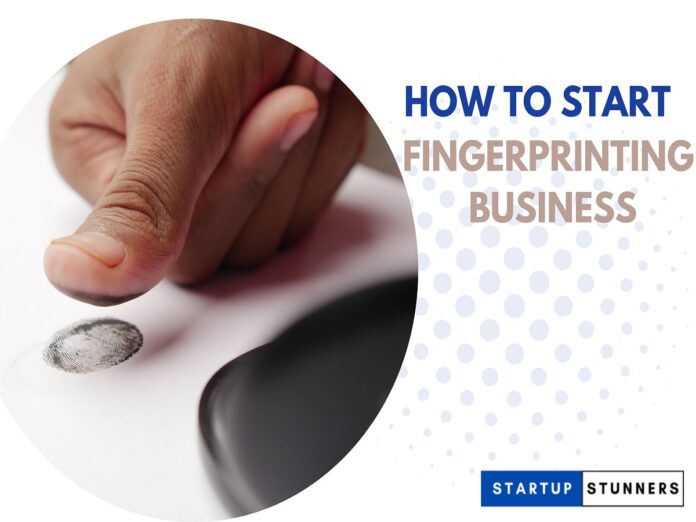Fingerprinting is the process of obtaining an individual’s fingerprints for identification purposes. Fingerprinting businesses offer their services to a variety of organizations and individuals, including government agencies, employers, and individuals seeking background checks. Because of the importance of fingerprinting in today’s society, these businesses are becoming increasingly popular.
This blog post will guide you everything you need to know to start a fingerprinting business in the United States. We will go over market research, business planning, fingerprinting certification, the Livescan fingerprint machine, mobile fingerprinting business, and the steps required to get your fingerprinting business up and running. You will have a thorough understanding of how to start a successful fingerprinting business by the end of this blog post.
Quick Overview
| Steps | Description | Challenges | Tips & Tricks |
|---|---|---|---|
| 1. Market Overview | Conduct market research to understand demand, target customers, competitors, and trends. | Reliable data collection, analyzing trends accurately. | Utilize online research tools, network with industry professionals, attend relevant events. |
| 2. Prepare Business Plan | Define objectives, conduct SWOT analysis, outline strategies, detail plans with projections. | Realistic financial projections, risk identification. | Contact Professional Business Plan Writer |
| 3. Investment Requirements | Determine costs for equipment, location, staff, marketing. | Securing funding, managing expenses, evaluating ROI. | Prepare comprehensive list, explore funding options, seek competitive quotes for equipment. |
| 4. Pricing Strategy | Analyze costs, competition, market demand, set pricing tiers/packages. | Balancing profitability and competitiveness. | Consider bundling services, adjust prices based on market dynamics, monitor competitors’ pricing. |
| 5. Certification | Identify and obtain necessary certifications based on local regulations. | Staying updated on certification requirements. | Research requirements, seek guidance, allocate sufficient time for the process. |
| 6. Licenses and Permits | Identify and obtain required licenses and permits for operation. | Understanding specific licensing requirements. | Research requirements, seek assistance, begin the application process well in advance. |
| 7. Insurance | Determine necessary coverage, obtain quotes, select and purchase policies. | Determining appropriate coverage and managing costs. | Consult with insurance professionals, review policies carefully, reassess needs as business grows. |
Step 1: Market Overview of Fingerprinting Business
The fingerprinting industry in the United States has grown steadily in recent years, owing to increased demand for background checks in a variety of industries, including healthcare, education, and law enforcement. The Fingerprint biometrics market revenue in 2022 was US$ 20.3 Billion. The market is expected to reach US$ 67.1 Billion by 2033, as it is estimated to grow at a CAGR of 11.6% for 2023 to 2033.
Mobile fingerprinting services have also grown in popularity, as they provide a more convenient and efficient way for customers to have their fingerprints taken. This trend is expected to continue, particularly in urban areas where busy professionals may be unable to visit a physical location for fingerprinting.
Step 2: Prepare business plan
When starting any business, including a fingerprinting business, having a well-thought-out business plan is crucial. A business plan serves as a roadmap that outlines your goals, strategies, and actions to achieve success. It provides a comprehensive overview of your business, its target market, competition, financial projections, and marketing strategies.
Startup Stunners has been providing high-quality business plan writing services for years, and we’re ready to assist you in developing a comprehensive, effective plan that will propel your company forward. Our team of experts is committed to assisting you in achieving your business objectives and obtaining funding from banks, grants, or other sources. We’re here to help you succeed whether you’re a beginner, entrepreneur, or small business owner. Don’t put it off any longer; visit startupstunners.com/contact-us/ today and let us lead you to success!
Step 3: Investment required for Fingerprinting Business
Startup Cost
The cost of starting a fingerprinting business varies depending on the location, services offered, and equipment required. Here are some examples of typical startup costs to consider:
- Legal and regulatory fees: These include the costs of obtaining a business license, registering with the state, and obtaining fingerprinting certification. Legal fees may also be required to ensure that state and federal regulations are followed.
- Equipment Costs: Depending on the type of fingerprinting services provided, equipment costs can vary significantly. A Livescan machine, which can cost $10,000 to $20,000 or more, is required for electronic fingerprinting. Ink pads, fingerprint cards, computers, and software may also be required.
- Office Space and Rent: For storing equipment and providing fingerprinting services, a physical office space may be required. The rent will be determined by the location and size of the space.
- Marketing and Advertising: Depending on the marketing strategy, marketing and advertising costs will vary. This may include the creation of a website, business cards, brochures, and online advertising.
Potential Funding Sources
Several funding sources are available to assist with the startup costs of a fingerprinting business:
- Personal savings: Using personal savings to fund a small business startup is a common method. It provides complete control over the business and prevents debt accumulation.
- Small Business Loans: Banks, credit unions, and the Small Business Administration can all provide small business loans (SBA). Typically, these loans have lower interest rates and longer repayment terms.
- Grants: Small businesses can apply for a variety of government and private grants. However, these grants can be competitive and require a significant amount of time and effort to apply for.
- Investors: In exchange for equity or ownership in the company, investors can provide funding for a fingerprinting business. This option is risky because it involves selling a portion of the company to a third party.
- Crowdfunding: It is a relatively new funding option that allows for capital to be raised through small contributions from a large number of people. This is possible via online platforms such as Kickstarter or Indiegogo.
Step 4: Pricing Strategy
Starting a fingerprinting business requires careful consideration of the best pricing plan. The success and profitability of your business are significantly influenced by pricing. To make sure that your pricing is competitive, appealing to clients, and in line with your financial objectives, it is necessary to carefully analyse a number of aspects. When creating a price strategy for your fingerprinting business, keep the following aspects in mind:
- Cost study: It’s critical to carry out an exhaustive cost study before establishing your prices. Identify all the costs associated with operating your fingerprinting business, including rent, utilities, personnel salaries, equipment expenditures, and overhead charges. Knowing your costs will enable you to calculate the lowest price at which you can cover your costs and turn a profit.
- Market Research: Conducting market research is vital to gain insights into the pricing landscape of fingerprinting services in your area. Examine the price strategies, service packages, and any added benefits that your rivals offer to customers. With the perception of the value of your own services in mind, this information will assist you in positioning your pricing plan competitively.
- Value-Based Pricing: Take into account using this pricing method. This strategy entails setting the price for your fingerprinting services based on the distinctive value you provide to clients. Determine the advantages and benefits that set your company apart from rivals, such as convenience, knowledge, technology, or extra services. You may defend a higher price point by focusing on these unique selling points.
- Pricing Structure: Determine how you will structure your pricing. You can choose to design tiered pricing based on the complexity or volume of the work, or you can choose a straightforward flat cost for each fingerprinting service. For instance, you might provide a basic plan for individual clients and a premium package for businesses or those in need of extra services like background checks.
- Discounts and Special Offers: To draw in new clients and promote repeat business, think about including discounts or special offers into your pricing strategy. Offering new customer specials, rewards for referrals, or loyalty programmes can cultivate client loyalty and encourage good word-of-mouth.
- Flexibility for Profitability: It’s crucial to maintain competition, but you also need to make sure that your price supports both sustainability and profitability. When determining your prices, take your intended profit margins and growth goals into account. Remember that setting your prices too high will turn away potential clients, while setting them too cheap can cause long-term financial pressure.
- Regular Review and Adjustments: Pricing is not a one-time decision. Continual examination and modification are necessary depending on customer feedback, cost changes, and market dynamics. Make sure your pricing approach is consistently competitive, profitable, and in line with the value you offer by conducting regular assessments.
Calculating the right pricing strategy is crucial for the success of any business. It directly affects your revenue streams and profitability. To help you with this important aspect, we have developed a convenient tool on our website. Our pricing calculator allows you to determine the optimal price for your services based on a markup basis. Access our pricing calculator tool to simplify the process and ensure you are setting competitive and profitable prices for your business
Step 5: Certification of Fingerprinting Business
Starting and running a fingerprinting business requires fingerprinting certification. Certification guarantees that the company follows industry standards and best practices, as well as legal and regulatory requirements.
For fingerprinting professionals, there are several types of certification available, including:
- Certified Fingerprint Examiner (CFE): The International Association for Identification (IAI) offers the CFE certification, which is intended for individuals working in forensic science, law enforcement, or security. This certification requires at least two years of fingerprint examination experience as well as passing a written and practical examination.
- Certified Latent Print Examiner (CLPE): The IAI also offers the CLPE certification, which is designed for individuals who specialize in latent print examination. This certification requires at least five years of experience in latent print examination as well as passing a written and practical exam.
- Fingerprint Certification: Fingerprint certification is required for individuals who want to provide fingerprinting services to the public and is provided by various state and local agencies. This certification’s requirements vary by state, but typically include completing a training program and passing a written examination.
Step 6: Obtaining licenses and permits for Fingerprinting Business
Depending on state and local regulations, you may need to obtain certain licenses and permits to start a fingerprinting business in the United States. The requirements will differ depending on whether you intend to run a mobile or fixed location business.
Here are some examples of common licenses and permits:
- Business License: Your state or local government may require a general business license to operate a fingerprinting business.
- Fingerprinting License: Some states may require you to obtain a license in order to provide fingerprinting services.
- Professional License: A professional license may be required if you intend to provide professional services such as notary public or private investigator services.
- Tax Registration: You must register for federal, state, and local taxes like income tax, sales tax, and employment tax.
- Zoning Permit: If you intend to operate your business from a fixed location, you may need a zoning permit.
Learn more about licensing requirements in your state by visiting SBA’s reference to state licenses and permits.
Step 7: Arranging Insurance
When starting a fingerprinting business, insurance is an important consideration because it can help protect your company from financial losses caused by unexpected events or accidents.
Here are some insurance options to consider for your fingerprinting business:
- General Liability Insurance: This type of insurance protects your company from third-party claims for property damage, bodily injury, and other damages.
- Professional Liability Insurance: Also known as errors and omissions insurance, this type of insurance can protect your company from claims of negligence, errors, or omissions in the provision of fingerprinting services.
- Cyber Liability Insurance: This type of insurance can protect your company from data breaches or other cyber-attacks that could lead to the loss of sensitive customer information.
- Business Property Insurance: This type of insurance can protect your company’s property from damage or loss as a result of theft, fire, or other covered events.
- Workers’ Compensation Insurance: If you employ people, you may be required to carry workers’ compensation insurance to cover medical expenses and lost wages if an employee is injured on the job.
Fingerprint Machine for Livescan
Fingerprinting machines capture and digitize fingerprints for use in identification. Ink and roll fingerprinting machines, optical scanners, and Livescan machines are among the various types of fingerprinting machines available.
Livescan machines are the industry’s most advanced and widely used fingerprinting machines. They are electronic machines that use a scanner to capture and digitize fingerprints. Livescan fingerprinting machines are preferred over ink and roll fingerprinting machines because they provide a more accurate and detailed image of the fingerprint, making identification easier.
There are various types of Livescan machines available, such as:
- Single-Platen Livescan Machines: The most basic type of Livescan machine is the single-platen Livescan machine. They have a single scanning surface and provide basic fingerprinting services.
- Multiple-Platen Livescan Machines: These machines have multiple scanning surfaces and can capture multiple sets of fingerprints at the same time. As a result, they are ideal for high-volume fingerprinting services.
- Portable Livescan Machines: Portable Livescan machines are designed for mobile fingerprinting services and are lightweight. They are easily transportable and are ideal for fingerprinting services at events or in remote locations.
The price of a Livescan machine varies depending on the brand, model, and features. A Livescan machine can cost anywhere from $2,500 to $15,000 or more. There may also be ongoing machine maintenance fees, such as software updates, calibration, and repairs. These fees can range from a few hundred dollars to several thousand dollars per year, depending on the manufacturer.
Advantages and Disadvantages of a Mobile Fingerprinting Business:
Advantages:
- Convenience: One of the most significant benefits of a mobile fingerprinting business is the convenience it offers. Customers can have their fingerprints taken in the privacy of their own home or office, eliminating the need to travel to a physical location.
- Flexibility: Because they can work around the customer’s schedule, mobile fingerprinting businesses provide greater scheduling flexibility.
- Economical: A mobile fingerprinting business can save money on rent and other overhead costs associated with a physical location.
- Increased Demand: Mobile fingerprinting services are in high demand, particularly in rural or remote areas where access to traditional fingerprinting services may be limited.
Disadvantages:
- Limited Coverage Area: A mobile fingerprinting business’s coverage area is limited because it may not be able to travel long distances to serve customers.
- Equipment Limitations: Mobile fingerprinting equipment may be less advanced or reliable than equipment in a physical location, which can have an impact on the quality of the fingerprints taken.
- Safety Concerns: When traveling to unfamiliar locations, mobile fingerprinting businesses may face safety concerns.
Conclusion
In conclusion, starting a fingerprinting business in the US market can be a profitable and rewarding venture. Before embarking on this journey, it is important to conduct extensive research on the industry and local regulations.
It is critical for success to create a comprehensive business plan that includes all necessary licenses and permits, equipment, and financial projections. It is also necessary to obtain certification and training for yourself and your staff in order to provide high-quality services and build a strong reputation.
Frequently Asked Questions
What exactly is a fingerprinting business?
Fingerprinting business provides fingerprinting services for a variety of purposes, including employment background checks, criminal history checks, and security clearances.
What are the main services provided by a fingerprinting business?
Fingerprinting business’s primary services include fingerprinting for background checks, criminal history checks, and other security purposes.
Do I need to be certified in order to start a fingerprinting business?
While certification is not always required to start a fingerprinting business, it can boost your credibility and give you a competitive advantage in the industry.
What is the cost of starting a fingerprinting business?
The cost of starting a fingerprinting business varies depending on factors such as equipment costs, location, and licensing fees. However, an approximate range of startup costs is $10,000 to $50,000.
What equipment is required for a fingerprinting business?
Livescan fingerprint machine, fingerprinting cards, ink pads, and other supplies for fingerprinting and recordkeeping are required for a fingerprinting business.
What exactly is a mobile fingerprinting company?
A mobile fingerprinting business is one that provides fingerprinting services on the go, traveling to different locations to serve customers.
Is insurance required for my fingerprinting business?
Yes, insurance is recommended for a fingerprinting business in order to protect against potential financial losses caused by accidents, data breaches, or other unforeseeable events.
Do I need any licenses or permits to start a fingerprinting business?
Depending on the state and local regulations, the licenses and permits needed to start a fingerprinting business may differ. A general business license, fingerprinting license, professional license, tax registration, and zoning permit are examples of common licenses and permits. It is critical to research local requirements and obtain all necessary licenses and permits.






